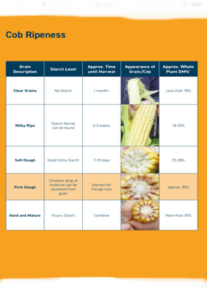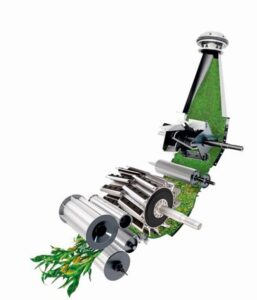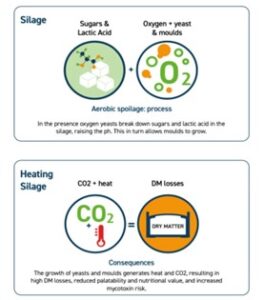When to harvest?
It’s a crucial question to which there is a definitive answer: when the maize is at 32-35% dry matter.
If the dry matter percentage is lower than this then the maize will loose nutrients in effluent. (The nutritional value of immature maize is in any case sub-optimal , the starch content being not yet fully realised). On the other hand, if the dry matter percentage is too high then the maize is harder to chop and harder to consolidate and seal anaerobically in the clamp. This could be a real possibility with some 2023 crops effected by the early drought conditions.
Maize plants ready for harvesting will have dry husks, two to three green leaves under the ear and the so-called ‘milk line’ (which moves down the grain as the milky moisture content shrinks) will be visible about half way down the grain.
It’s also possible to work out dry matter content by simply weighing samples before and after drying them out thoroughly.
Weather conditions at harvesting should obviously be dry – not just to protect the crop’s dry matter content but to minimise contamination by soil, which contains harmful organisms and should not be introduced to the clamp from muddy tractors and trailers.
Harvest Processing
Cutting height is a balancing act: low enough to maximise yield while high enough to avoid contamination by soil and weeds. In good conditions the crop can be cut as low as 150mm but as the 2023 growing season has left a lot of tall high lignin content crops. In these conditions the plants lower stems have a very high lignin concentration 300-500mm may be required. It is essential that cutting height is harvesting the lowest cob.
Chop size depends on what the maize is for: it can be shorter when making silage for AD plants than when making it for fodder. However, even in the latter case, though the strands need to be long enough to be chewed, too long and animals may refuse them (as well as the particles not settling as well in the clamp). The chop size should therefore not exceed 2cm and an ideal of 1-1.5cm is recommended.
The maturing maize grains will be broken up by the grain crushers on most silage harvesters, a job that becomes more important as the 35% dry matter mark approaches and the starch in the grain gets harder and glassier.
Ensiling
Another balancing act: work quickly in order to minimise aerobic spoilage, but not so quickly that care taken over constructing and compacting the silage is compromised. This challenge often simply means synchronising the work of those filling the clamp with the work of those compacting it.
Keeping air out is the key principle. To seal out oxygen is in practice to seal out undesirable spoilage organisms; it’s the difference between fermentation (which actually improves the digestibility and starch content of the maize over time) and simple decay. 
Strive, therefore, not to leave any air pockets as you carefully fill the clamp layer by layer. Optimal compaction can be achieved by not making the layers too thick (15cm is recommended) and by ensuring that the tyre pressure of the tractor rolling over the silage is not too low (i.e. not below road pressure).
Polythene sheeting around the clamp, enhanced by weights, should then be used to create an airtight seal.
Once the silage begins to be used it should be as little exposed to air and light as possible. The size of the front opening should be small enough to be moved across in its entirety at least once a week. It is invaluable to silage quality that you continue to guard against contamination from dirt by keeping the surrounding area clean.
Whole-crop cereal silages, such as maize and wheat are susceptible to aerobic deterioration, especially in warm climates. This is because aerobic yeasts are the most active at 20 to 30°C (Ashbell et al., 2002). Therefore, it is very important to find suitable additives that inhibit fungi and protect the silage upon aerobic exposure. In order to improve the ensiling process, various types of additives have been developed. The biological additives are advantageous because they are safe and easy to use, non-corrosive to machinery, do not pollute the environment, and are natural products. Until now bacterial inoculants have been added to silage in order to stimulate lactic acid fermentation, accelerating the decrease in pH, and thus improving silage preservation. Most available inoculants consist of selected strains of homofermentative LAB (Brevis ) vstrains. They produce large amounts of lactic acid in the silage in a short time and so stabilise it with minimal losses. However, these homofermentative LAB strains enhance aerobic deterioration of whole-crop cereal silages, probably because not enough VFA are produced to inhibit fungi (Wein- berg et al., 1993). This agrees with our previous experiments (Filya et al., 2000; Filya, 2002a,b) with wheat, sorghum, and corn silages.
Lactobacillus buchneri is a heterofermentative LAB, which produces high levels of acetic acid in silage. Results with this microorganism in laboratory studies were promising with regard to aerobic stability (Drie- huis et al., 1999a,b; Filya, 2001, 2003; Kung and Ranjit, 2001; Filya et al., 2002; Ranjit et al., 2002; Weinberg et al., 2002).
The results indicate clearly that inoculation with L. buchneri alone or in combination with a homofermentative LAB improved the aerobic stability of Maize silages.
Silage Analysis
The nutritional profile of silage varies every year: it is a natural product that reflects variable growing conditions. It is necessary to take samples for testing. The resulting analysis of everything from crude fibre to nitrogenous matter percentages.
This will help you put the silage to best possible use when it comes to formulating rations with your NWF feed specialist..
Much of the country is looking for a bumper harvest. This will not be the case in drought hit crops. High starch due to dryness and more mature crops. Maize will be great for finishing stock but may pose issues of acid loading in the dairy diet.
By NWF Forage Specialist, Jonathan Jackson.
